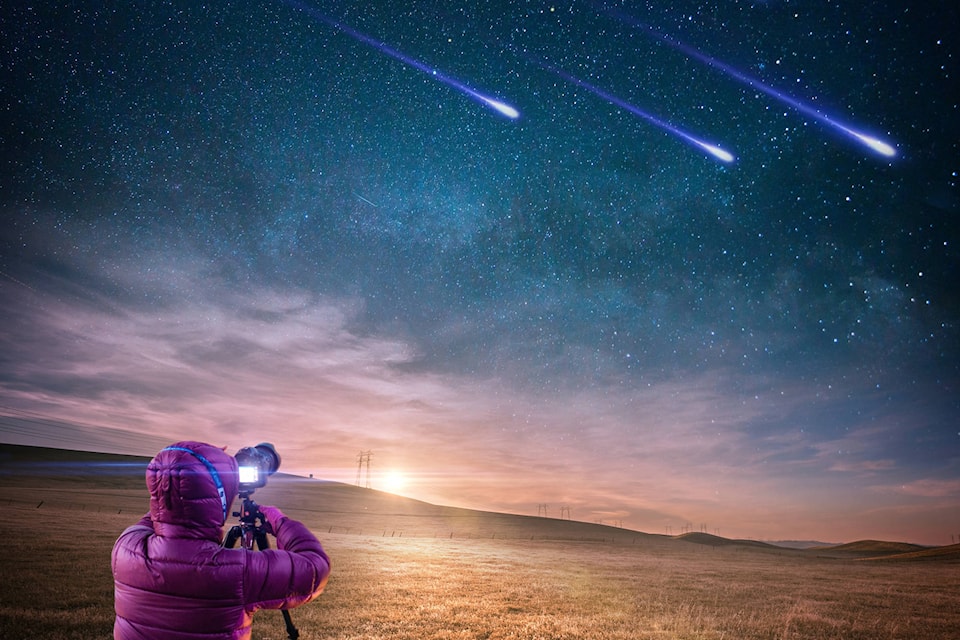This month is an interesting one for skywatchers, from professionals to casual observers.
There is the solar eclipse coming up on Aug. 21, but before that, there is the annual Perseids meteor shower, which peaks on Aug. 12.
Clouds sometimes interfere with viewing the spectacular light show, but this year, smoke is more likely to be the culprit.
| Ken Tapping is an astronomer with the Dominion Radio Astrophysical Observatory. (Photo courtesy David Szabo) |
“It should be possible to see something unless the smoke gets very, very thick.”
But the viewing event planned at DRAO goes on regardless, according to Tapping. It starts at 7:15 p.m., with talks starting at 8 p.m. and running to 9:30 p.m.
Related: Okanagan Valley has best view of celestial light show
“After that, we will go out and hopefully see something,” said Tapping. What viewers are watching, he explains, is the debris left by a former comet, with the main part evaporated by countless orbits around the sun.
“What happens is this dust and grit that is released by the object as it disintegrates, gradually fills the whole orbit,” said Tapping. “You have this big stream of dust and grit and bits of ice moving at speeds of 50,000 kilometres an hour or faster.”
When the Earth runs through the stream every August, friction heats some of those bits up as they collide with the atmosphere.
“They heat up to thousands of degrees, very very quickly. What we see is this streak of glowing air and glowing disintegration material from this grain of stuff,” said Tapping.
The spectacular streaks across the sky are made by very tiny meteors, the size of a sand grain, ranging up to as big as a pea for a really big one. The show is done there, but the remains end up as fine dust that gradually gets brought down by the rain and snow.
“The Earth is actually gaining weight at about 100 tonnes a day of debris from meteors,” said Tapping.
You can also hear the meteors, with the help of a radio. Tapping said they conducted this experiment last year and are planning to try it again at this year’s event.
As the meteors burn up in the atmosphere, the resulting super-heated air is able to reflect radio waves, allowing you to listen to far off radio stations as the signal “skips” off the plasma.
“I’ve done this experiment at home, and even with my car radio. You can do it most mornings driving to work,” said Tapping. “I set my car radio to 102.3 FM, and I can pick meteor echoes from the radio station Sunny 102 FM in Modesto, California.
The flash of the meteor in the sky results in a half second or a second of radio bursting through the background static.
“I was driving past Skaha lake once and had 30 seconds of Shania Twain, a Canadian artist relayed back to Canada by a meteor,” said Tapping. The effect is most pronounced in the morning around 6 a.m. and at its lowest at 6 p.m.
“Every few minutes you will hear a sudden burst of a signal coming out of the noise or a bit of music. A good one will give you up to half a minute of the really strong signal,” said Tapping. “Science doesn’t come much cheaper than that. “
The Perseids will gradually disappear, along with all the other meteor showers we have at the moment, Tapping said, as the streams get swept clean.
“There will be others and that will be continuing for the foreseeable future,” said Tapping. “Somebody discovers a new comet and that is the beginning of another episode in this process.”
Tapping said one of the wonderful things about astronomy, as opposed to a science like elementary particle physics, is that it can be enjoyed from the pure scientist to someone who just enjoys looking at beautiful spectacles.
“Most of us are somewhere in the middle,” Tapping said. “You go out and enjoy it because it is beautiful and wonderful and we are a part of it.”
Hopefully, the smoke blanketing B.C. will be lightened or gone by Aug. 21, but even if there is still a thick layer of cloud, Tapping said you should avoid looking at the eclipse without proper eye protection.
“Staring at the sun is dangerous. Even if you get up in the morning and see this deliciously red sun because of the smoke and it doesn’t look that bright, it doesn’t mean it is safe to stare at,” said Tapping. “Your eyes might be seeing less light, but the infrared might be still coming in full strength. It is the infrared that gets focused on the back of your eye or does the damage.”
Tapping cautions that to watch the eclipse, you need to get the right equipment. He points to the Sirius Science store in Penticton as a source for the proper viewing goggles. London Drugs is also selling approved viewing shades.
“There are other places, you can go and get these eclipse goggles that are made of safe material and not something cheap on the web,” said Tapping.
But there is more to the eclipse than looking at the sun.
“Don’t just go out and look at the eclipse. During the eclipse, go around and look at what is happening around you. It is amazing,” said Tapping.
“There are all sorts of interesting things you can see during an eclipse if you just take note of what is happening around you. Birds stop singing, the lighting changes, things start to look different, things start to look weird.
“It’s a whole experience,” said Tapping.



